

Full reptend prime. In number theory, a full reptend prime or long prime in base b is a prime number p such that the formula (where p does not divide b) gives a cyclic number.
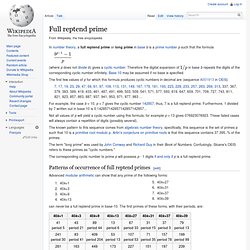
Therefore the digital expansion of in base b repeats the digits of the corresponding cyclic number infinitely. Base 10 may be assumed if no base is specified. The first few values of p for which this formula produces cyclic numbers in decimal are (sequence A001913 in OEIS) Not all values of p will yield a cyclic number using this formula; for example p = 13 gives 076923076923. The known pattern to this sequence comes from algebraic number theory, specifically, this sequence is the set of primes p such that 10 is a primitive root modulo p. Number theory.
Ácido cianhídrico. Historia del descubrimiento[editar] El ácido cianhídrico fue aislado por primera vez desde el tinte azul (azul de Prusia), este tinte era conocido ya desde 1704 pero su estructura molecular era completamente desconocida.
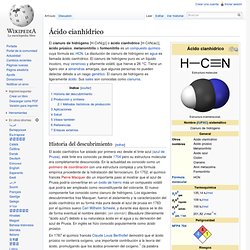
En la actualidad es conocido como un polímero de coordinación con una estructura compleja y una fórmula empírica procedente de la hidratación del ferrocianuro. En 1752, el químico francés Pierre Macquer dio un importante paso al mostrar que el azul de Prusia podría convertirse en un óxido de hierro más un compuesto volátil que podría ser empleado como reconstituyente del colorante. El nuevo componente fue conocido como cianuro de hidrógeno. Producción y síntesis[editar] El cianuro de hidrógeno se produce en grandes cantidades en todo el mundo por la industria química. Las frutas que tienen una semilla grande, como el aguacate o el albaricoque, generalmente tienen pequeñas cantidades de cianuro de hidrógeno en su semilla.
Cermet. A cermet is a composite material composed of ceramic (cer) and metallic (met) materials.
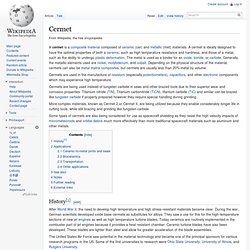
A cermet is ideally designed to have the optimal properties of both a ceramic, such as high temperature resistance and hardness, and those of a metal, such as the ability to undergo plastic deformation. The metal is used as a binder for an oxide, boride, or carbide. Generally, the metallic elements used are nickel, molybdenum, and cobalt.
Depending on the physical structure of the material, cermets can also be metal matrix composites, but cermets are usually less than 20% metal by volume. Robotics. Robotics is the branch of mechanical engineering, electrical engineering and computer science that deals with the design, construction, operation, and application of robots,[1] as well as computer systems for their control, sensory feedback, and information processing.
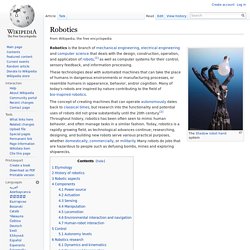
These technologies deal with automated machines that can take the place of humans in dangerous environments or manufacturing processes, or resemble humans in appearance, behavior, and/or cognition. Many of today's robots are inspired by nature contributing to the field of bio-inspired robotics. The concept of creating machines that can operate autonomously dates back to classical times, but research into the functionality and potential uses of robots did not grow substantially until the 20th century.[2] Throughout history, robotics has been often seen to mimic human behavior, and often manage tasks in a similar fashion.
Etymology[edit] Nanotechnologie. Neue Materialien wie Fullerene (d) oder Carbon-Nanotubes (h) sind Nanotechnologie und werden schon jetzt in vielen Gebieten eingesetzt.
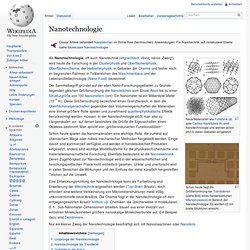
Schon heute liegt die Größenordnung der Transistoren (siehe Bild) eines handelsüblichen Mikroprozessors im Bereich der Nanotechnologie. Es werden 22 nm breite Strukturen erreicht. Der Sammelbegriff gründet auf der allen Nano-Forschungsgebieten zu Grunde liegenden gleichen Größenordnung der Nanoteilchen vom Einzel-Atom bis zu einer Strukturgröße von 100 Nanometern (nm): Ein Nanometer ist ein Milliardstel Meter (10−9 m). Bionics. Bionics (also known as bionical creativity engineering) is the application of biological methods and systems found in nature to the study and design of engineering systems and modern technology.

[citation needed] The transfer of technology between lifeforms and manufactures is, according to proponents of bionic technology, desirable because evolutionary pressure typically forces living organisms, including fauna and flora, to become highly optimized and efficient. A classical example is the development of dirt- and water-repellent paint (coating) from the observation that the surface of the lotus flower plant is practically unsticky for anything (the lotus effect). [citation needed]. Ekso Bionics is currently developing and manufacturing intelligently powered exoskeleton bionic devices that can be strapped on as wearable robots to enhance the strength, mobility, and endurance of soldiers and paraplegics. Bangkok. Bangkok (English pronunciation: /ˈbæŋkɒk/[5]) is the capital and the most populous city of Thailand.
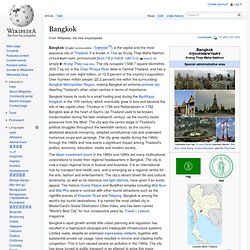
It is known in Thai as Krung Thep Maha Nakhon (กรุงเทพมหานคร, pronounced [krūŋ tʰêːp mahǎː nákʰɔ̄ːn] ( )) or simply Krung Thep . The city occupies 1,568.7 square kilometres (605.7 sq mi) in the Chao Phraya River delta in Central Thailand, and has a population of over eight million, or 12.6 percent of the country's population. Over fourteen million people (22.2 percent) live within the surrounding Bangkok Metropolitan Region, making Bangkok an extreme primate city, dwarfing Thailand's other urban centres in terms of importance. Bangkok traces its roots to a small trading post during the Ayutthaya Kingdom in the 15th century, which eventually grew in size and became the site of two capital cities: Thonburi in 1768 and Rattanakosin in 1782.
The Asian investment boom in the 1980s and 1990s led many multinational corporations to locate their regional headquarters in Bangkok. Fermat number. In mathematics, a Fermat number, named after Pierre de Fermat who first studied them, is a positive integer of the form where n is a nonnegative integer.
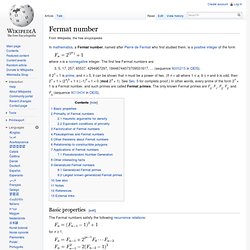
The first few Fermat numbers are: Wetware (brain) Wetware is a term drawn from the computer-related idea of hardware or software, but applied to biological life forms.
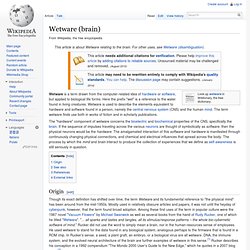
Here the prefix "wet" is a reference to the water found in living creatures. Wetware is used to describe the elements equivalent to hardware and software found in a person, namely the central nervous system (CNS) and the human mind.